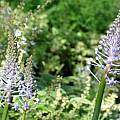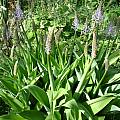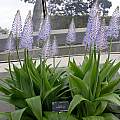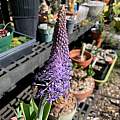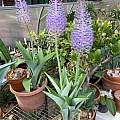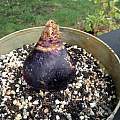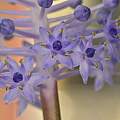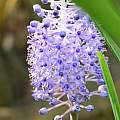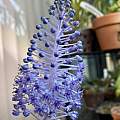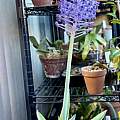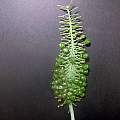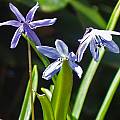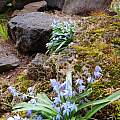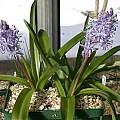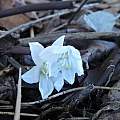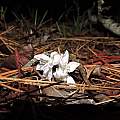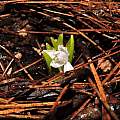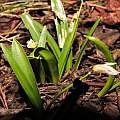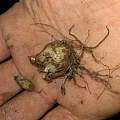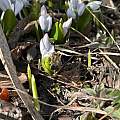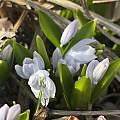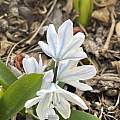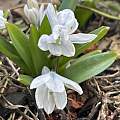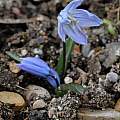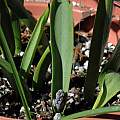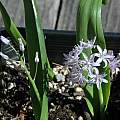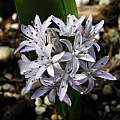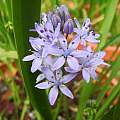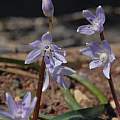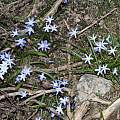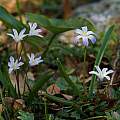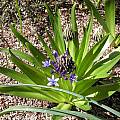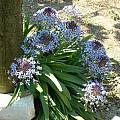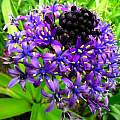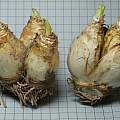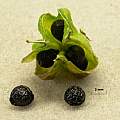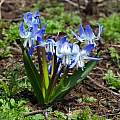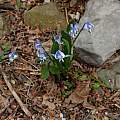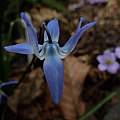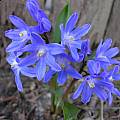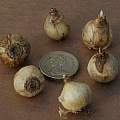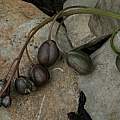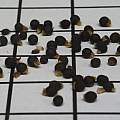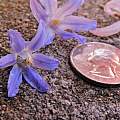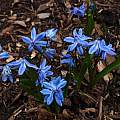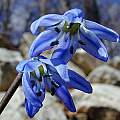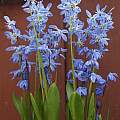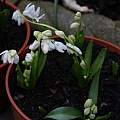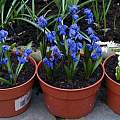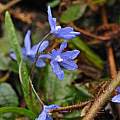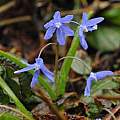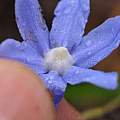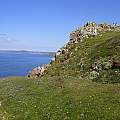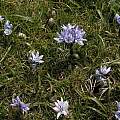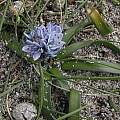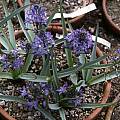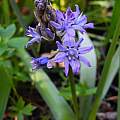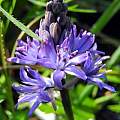Scilla species m-z are found on this page.
Scilla madeirensis Menezes, syn. Autonoe madeirensis (Menezes) Speta, is native to Madeira. This species has been discussed on the pbs list a number of times. It is thought to be rare in the wild, perhaps nearing extinction, but one correspondent from Madeira has seen it in a number of locations there flowering in September to October, although when grown in cultivation at Kew it blooms later as the dormant plants are not watered until October. It grows in nature in partially shaded or north facing rocky slopes in Madeira with very little fluctuation in temperature (not very hot or cold). It was described on the pbs list as growing in an "eternal spring" climate under the constant influence of the trade winds. It is only dry for a few months in summer, but there still is high humidity from cloud condensation in summer. Several growers have found that their plants do not set seed, but others have been more successful, some by pollinating with a paint brush and others find the bees do the job when flowering occurs when they are abundant. Seed pods take a number of months to dry off. If seeds can be obtained, they germinate easily, but like the mature bulbs need to be protected from frost. Mature bulbs are a distinctive purple color and are potted on the surface of the soil and pull themselves down a bit, but the neck and shoulders remain exposed. A blog post describes how they grow this species at Kew and shows photos of the mature bulbs and flowers. In referring to the color of the bulbs in the photos, Brian Whyer commented that "the Kew photos maybe exaggerate this because they have been inspected and well cleaned to minimize any mealy bug problems which they are prone to. The nice round young bulbs become quite scaly with age."
References are made to this species under the spelling of Scilla maderensis, both on the pbs list and the Internet. This spelling is not listed on IPNI, Plants of the World Online or World Flora Online. In 2011 the pbs list correspondent from Madeira described this plant as "a very rare variant known only to occur in the remote archipelago of Selvagens Islands, and even here they only grow on the Selvagem pequena, an islet which is less than 1 km square of area. The amazing thing is that the flowers are scented and might be pollinated by endemic lizards... The leaves are more silvery too and I suspect this might be a new species as it differs a lot from the standard form."
The first two photos below were taken by Brian Whyer who saw it in a nursery growing in a 12" (30 cm) diameter pot, with stems to no more than 24" (60 cm). The bulbs visible on the soil surface were about tennis bulb size. The third photo was contributed by Terry Laskiewicz and was taken at the Kew Gardens early December 2010. The last three photos were supplied by Ken Preteroti who had obtained a bulb from Longwood Gardens.
The first two photos from Arnold Trachtenberg who writes: "I think the point about a hard dry summer rest is important. I let mine sit on the basement shelf without any moisture for the entire season." Photos of the flowers from Mike Lowitz. The photo of the seed pods is from Pamela Slate.
Scilla mauritanica Schousb. is a synonym of Hyacinthoides mauritanica ssp. mauritanica
Scilla melaina Speta is one of the small scillas, endemic to the mountains of Turkey. Its seeds were sown in a 4" container in a raised bed in the garden in Tumwater, Washington -USA- (USDA zone 7A), and reached first flowering in 4 years. It has been trouble free; the slugs don't even seem to bother it. Photos by Dave Brastow and Terry Laskiewicz.
Scilla messeniaca Boiss. was proposed to be moved to Schnarfia and named Schnarfia messeniaca in the proposed Scilla split, but this was not accepted. It is from southern Greece. It has broad leaves and naturalizes in gardens, but the leaves suffer in very wet winter climates. Photos by John Lonsdale.
Scilla mischtschenkoana Grossh. (syn. Scilla tubergeniana, Othocallis mischtschenkoana) is a diminutive species with an almost unpronounceable name native to the Caucasus. It is often found growing with Puschkinia, to which it bears a resemblance. The difference is that the filaments of Puschkinia are flattened and fused, while those of S. mischtschenkoana are independent of each other. S. mischtschenkoana blooms very early in the year, often in late February or March before many Narcissus have even broken ground. This species also often flowers before it is fully above ground, and often before the leaves emerge. The leaves are green and strap like, and unlike Puschkinia (whose leaves emerge curled in a cone shape) are not able to push through a leaf mulch if it is too thick. The selection Scilla mischtschenkoana 'Tubergeniana' is often incorrectly sold as "Scilla tubergeniana". The first two photos show flowers appearing before the leaves in the middle of February, 2015. The third photo shows a relatively later blooming individual blooming with the leaves mid March, 2015. The fourth photo shows the leaves. The last photo taken in June of 2015 shows the bulb which still has roots. Photos by Travis Owen.
Photo from iNaturalist taken by loesvm in Andorra in February and shared under a CC BY-NC license.
Scilla monanthos K.Koch is a low growing tiny species from mountain Areas in Turkey, Iran, and Iraq. In habitat, it flowers with the early snow melt and features a very prominent dark mid rib on the pale blue petals. For Martin Bohnet in southern Germany, it is the earliest of the Scilla species, flowering slightly before Eranthis hyemalis in the first spring after planting, and not delaying much in the years after so timing may change for established plants.
Scilla monophyllos Link is found in stony places in southwest Spain, Portugal, and Morocco. Its claim to fame is that it has only one broad leaf per bulb. Brian Mathew describes it as interesting because of this feature, but unexciting otherwise. It has small blue flowers. Height: 15 cm. Photos from Mary Sue Ittner who writes that the flowers on her plant are so pale, that calling them blue is a stretch. She still likes this plant and appreciates that it flowers in California in February before a lot of other flowers do. This species was proposed to be moved to Tractema, but this change was not accepted.
Scilla morrisii Meikle is endemic to the Island of Cyprus where it is extremely rare and endangered. It grows in partial shade to shade, humid habitats, blooming in February. Photo taken by Oron Peri of plants in his collection.
Scilla nana (Schult. & Schult.f.) Speta, syn. Chionodoxa nana (Schult. & Schult.f.) Boiss. & Heldr., Chionodoxa. cretica Jaub. & Spach, is from Crete where it occurs at elevations of 1700–2300 m. It is known as dwarf glory-of-the-snow. It has two leaves and one to five flowers per bulb. The flowers are pale blue with blue tips, and a blue stripe down the center of each petal. Height: about 15 cm. Photos from iNaturalist were taken by Felix Riegel in May in Crete and shared under a CC BY-NC license. In the last photo it is pictured with Crocus sieberi.
The form previously named Chionodoxa albescens (Speta) Rix. is included in Scilla nana. It has slightly smaller flowers, whitish with lavender tips. Photos from iNaturalist were taken by Sarah Gregg in March in Crete and shared under a CC BY-NC-SA license.
Scilla natalensis Planch. is a synonym of Merwilla plumbea
Scilla nervosa (Burch.) J.P.Jessop is a synonym of Schizocarphus nervosus
Scilla peruviana L. see the Scilla peruviana page.
Representative photos of this species. Photos by Bob Rutemoeller, Angelo Porcelli, Mary Sue Ittner, Kathleen Sayce and David Pilling.
Scilla puschkinioides Regel is a synonym of Fessia puschkinioides
Scilla rigidifolia Kunth see Schizocarphus nervosus
Scilla rosenii K.Koch bears reflexed tepals a la Cyclamen; in nature it grows in alpine meadows, mostly in dampish peaty medium, appearing soon after snow melts, often in astonishing numbers. Distribution is from northeast Turkey to the Transcaucasus; but it grows well enough for Jerry Flintoff in Washington in a raised bed in well-drained soil. Speta proposed moving this species to Othocallis, but this change was not accepted. Height: about 12 cm. Photo 1 was taken in habitat in Georgia by Oron Peri. Photos 2-3 of plants in cultivation by Rimmer de Vries.
Scilla sardensis (Whittall ex Barr & Sugden) Speta, syn. Chionodoxa sardensis Whittall ex Barr & Sugden, has up to 22 bell to star-shaped flowers up to 2.5 cm wide in a loose one-sided raceme. It is purple-violet in bud, violet at opening, fading to violet blue with very little white in the center apart from the filaments. The filaments are of even lengths and wide at the base, tapering to a point. Height: about 20 cm. Photo of flowers from Arnold Trachtenberg is probably of this species from Western Turkey although it could also be a hybrid. Photo of bulbs, seed pods and seed by David Pilling, the coin is about an inch in size and the grid 10 mm.
The photo below shows a flower of Scilla sardensis on the far left with a US quarter (just under an inch in diameter) for scale. The flowers do possess some white at the petal bases, but not as much as S. forbesii or S. luciliae.
Scilla scilloides see Barnardia japonica
Scilla siberica Andrews has blue flowers in early spring and is native to Russia and Eurasia, not Siberia. It is easily grown and self sows readily; it easily becomes invasive. The species was proposed to be moved to a new genus, Othocallis, but this change was not accepted. Photos were taken by Jay Yourch.
'Spring Beauty' is a cultivar of Scilla siberica. It can have five flower spikes per bulb each with three flowers. First photo by John Lonsdale, second David Pilling.
Scilla siberica alba is a white form. Photos by David Pilling, the second one compares the species, 'Spring Beauty' and alba.
Scilla sicula Tineo ex Guss. see Scilla peruviana L.
Scilla vardaria Yildirim & Gemici is a species published in 2013 described by Hasan Yildirim. As of the date of this description, it is only known from a small population in the Kaçkar Mountain range in the province of Rize in northeastern Anatolia. It was described assuming that Chionodoxa has been absorbed into Scilla, though it shares characteristics with both. Molecular studies have confirmed that it is closer to Scilla bifolia than Chionodoxa. The morphology of this species is very unique. It possesses six flattened filaments, similar to Chionodoxa, but they are fused to form a corona similar to Puschkinia. However, it differs from Puschkinia (which has a lobed tubular corona) by having a conical corona with an entire margin (rarely minutely lobed). The bulb has a brownish tunic and pink scales. The seeds of S. vardaria possess an elaiosome, unlike Puschkinia. The anthers are connected to the filaments at the apex of the corona. Pictures below of plants in habitat by Hasan Yildirim.
Scilla verna Huds., syn. Tractema verna (Huds.) Speta, was proposed to be relocated to the genus Tractema, but this change was not accepted. It is native to the Atlantic coast of Europe and grows on sea cliffs and grassy places. The pictures below were taken by Bob Rutemoeller in May 2004 on sea cliffs in Cornwall, England. The first picture shows the habitat, the second many of various shades of blue and white growing in grass and finally a close-up.
In 2025 Scilla ramburei Boiss. is considered to be a synonym of Scilla verna ssp. ramburei (Boiss.) K.Richt., sometimes spelled Scilla verna ssp. ramburii. It comes from North Africa and the southern Iberian Peninsula. It was proposed to be included in the new genus Tractema, but this change was not accepted. Height range: 15-30 cm. The first photo from Jane McGary shows it flowering in early spring in the bulb frame in northwestern Oregon. She wrote: "It is especially pretty with its full inflorescence and broad, glaucous leaves. It does not increase fast vegetatively but is easily grown from seed. The plants shown were grown from seed obtained from Monocot Nursery in England." The next two photos are from Mary Sue Ittner.
Scilla vincentina Link & Hoffmanns. is a synonym of Hyacinthoides mauritanica.
